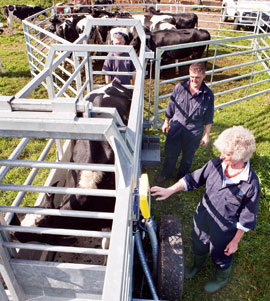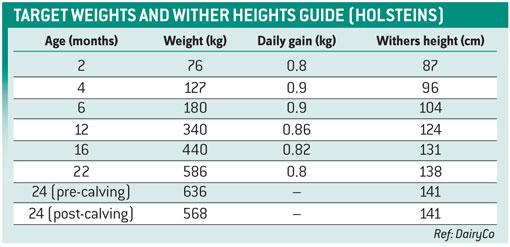Keeping track of heifer growth to secure herd success

Regular monitoring of heifer growth rates from a young age can help highlight areas for improvement and doesn’t necessarily have to be an added chore, as Aly Balsom reports.
Milk recording is used to monitor and manage yields and constituents to perfect performance, so why are we not doing the same with heifer growth rates?
Ensuring youngstock are on track to calve-in at the right size and the right age is crucial to their future performance within the herd, yet at least three-quarters of producers don’t do anything to monitor growth rates.
And vet Kat Bazeley, of Synergy Farm Health, explains that dairy producers who say they monitor by eye are not doing enough to ensure heifers achieve target growth rates.
“When you are ‘monitoring by eye’, you are not monitoring,” she says. “Heifers need to be achieving 0.7-0.8kg/day to hit the target of calving in at 24 months. This is hard to meet, so they can’t afford to have a holiday from growing, meaning that monitoring is essential.”
Ensuring heifers hit targets to calve-in at the most economic time of 24 months is one reason to monitor growth rates, but this is not the most important, she says.
“It is more important that heifers are big enough when they go to the bull. If you serve an animal before she is ready, she will calve-in too small and won’t last long in the herd.”
These individuals are more likely to be bullied, resulting in reduced lying times predisposing them to left displaced abomasums.
When to weigh
A lack of time and hassle are often used as an excuse for not weighing heifers, but it doesn’t necessarily have to be an added task, she says.
“The reality is you have to do something to heifers reasonably frequently, be it bolusing or TB testing, so the aim should be to weigh them when you are handling them anyway.
“The main thing is not to turn it into a chore and do it at a convenient time for you.” Ideally, weights should be recorded four times a year,” she adds.
Ms Bazeley also emphasises the need to start monitoring heifers from a young age to ensure any problems are picked up early – without doing so, it is all too common for stock to reach bulling age before any problems are picked up.
“It is very useful to record birth weight, but in reality this is often difficult to get. What is worth doing is highlighting calves that have a reason to be small, such as twins, so you can track patterns later.”
Weaning age is also an important time to monitor progression. “The aim should be for animals to double their birth weight by weaning,” she says.
Ms Bazeley also stresses the importance of continuing to monitor heifer growth rates while stock are at grass, something that is even more crucial this year.
“A lot of heifers are still outside on nothing more than grazed grass – this is simply not enough to maintain growth rates, and they won’t make it up when the come in.”
The warm weather in October also means parasites are still an issue and wormer cover may have run out, impacting on growth rates.
“Producers need to be on red alert. There is no harm in stock being outside as long as they are provided with extra rearer concentrate.”
How to record performance
Plotting a simple graph of weight against age is an extremely useful way of tracking growth and identifying any management issues that need addressing.
By plotting a batch of heifers, either on a sheet of paper or on a computer, one weighing can help establish where problems are occurring. The aim should be to achieve as little variation within a batch as possible, so a wide spread of weights on the graph will highlight an issue at that age. Equally, recording in such a pictorial way will highlight any individual stragglers that need special attention.
“Always investigate why variation is occurring,” says Ms Bazeley. “For example, if variation is occurring when heifers are at grass, it may be highlighting a lungworm problem. A spread of data at housing could also be linked to feed trough set up.”
Weight variation
A sample of 25 farms, recorded as part of Synergy Farm Health’s heifer monitoring service, found significant variation from herd to herd in terms of heifer performance and highlighted key times when problems commonly occur.
“A calf’s feed conversion efficiency is at its best in the first few weeks, yet the data shows a lot of calves don’t start growing until about three weeks old. This means they are simply not getting enough food at this crucial stage.”
These calves will be using their own reserves to put on frame, but not weight. Consequently they become thinner, and don’t have reserves to fight disease.
“The data also shows a 130kg variation in heifer weights at 200 days – the aim should be to have as little variation within a batch as possible,” she says.
Ms Bazeley explains how weaning to puberty, and puberty onwards, are two key times in a heifers growth cycle and pregnancy is a particular time when stock should not be laying down fat.
Consequently, when monitoring bulling heifers, there is a need to look at both condition score and weight.
“If heifers put on a lot of fat before puberty they will lay down fat cells in the udder and won’t give as much milk during lactation.”
How to monitor
Although weighing may be the gold standard in terms of accuracy of recording, there are a number of options available to monitor heifer performance. The main thing is to start monitoring in some way by selecting the method that best suits your system set-up.
The three main options available are as follows (see table below for target Holstein weight and wither heights):
Weigh scales
• Weighing is by far the easiest and most accurate way of monitoring heifers
• Body condition score bulling heifers, along with weighing.
Weigh band
A weigh band looks like a measuring tape and is used to measure heifer girth. The tape shows the girth measurement and corresponding weight
• Set up must be adequate to ensure safety during handling
• Weight variation from using weigh bands can be an issue
• It is crucial to use a specific dairy heifer weigh band to assess weights
• A specific youngstock tape should be used for calves under 100kg.
Wither height or growth stick
• A growth stick that marks ideal wither heights with age of animal can be an easy way of seeing whether youngstock are on track
• A line can also be marked on a wall at the target wither height for a specific age and heifers run past to see whether they are on target.

Key points
• Weighing doesn’t have to be an added chore – do it when you have to handle youngstock anyway
• It is crucial to start weighing from a young age. Don’t wait to bulling age when it is too late to correct problems
• Heifers should double their birth weight by weaning
• Record data and plot a line graph of age and weight – this will highlight when any problems are occurring
• Act on data
Funding for weigh scales
Producers can now apply for RDPE funding for weigh scales as part of the Farming and Forestry Improvement Scheme (FFIS), says DairyCo extension officer, Chris Coxon.
• An application can be made for weigh cells as part of a cattle crush or purchased as an additional item to add to an existing crush
• The closing date for applications under round one is 17 January 2012
• Visit DEFRA or contact your local RDPE team
Case study: Andrew Gillard, herd manager at Allowenshay Farm, Allowenshay, Somerset
Regular monitoring of heifer growth rates has helped reduce calving age by six months and raise bulling weight from 360kg to 390kg over two years at Allowenshay Farm, Somerset.
Herd manager Andrew Gillard explains how heifers are now achieving target bulling weights a lot quicker to calve-in at 550kg at between 22 and 24 months.
The organic farm uses Synergy Farm Health’s heifer monitoring service and mobile weigh scales to weigh youngstock every three months. Some weights are taken at birth, and then stock are weighed at weaning at three months old and every three months from then onwards.
“It’s important to weigh this regularly as it keeps us focused on heifer performance and allows us to pick out any individuals that aren’t performing,” says Mr Gillard.
Regular monitoring also allowed the farm to highlight a particular stage in the rearing process where heifers were not performing. “We noticed that heifers were losing weight when they were at grass during the autumn. As a result, we began feeding cake and silage and consequently weight gains got back up to about 0.8kg a day.”
Heifers are also now fed about 1kg more cake throughout the summer, adding about £100 a head to costs, however they are calving six months earlier.
“As a result, we’re getting about an extra 25 litres a heifer a day – at 35p a litre this means each animal is giving us £1,500 more, so it’s well worth it,” says Mr Gillard.
How to monitor heifer growth rates
Somerset producer Neil Baker speaks about how he uses a weigh tape to track heifer growth
Monitoring heifer for weaning – with Paula Wilson from Scarsdale Vets
Related articles
• Boost heifer performance by tracking growth
